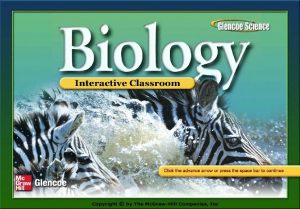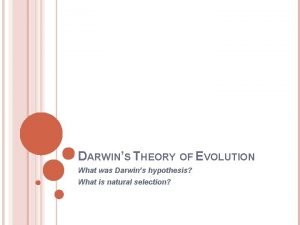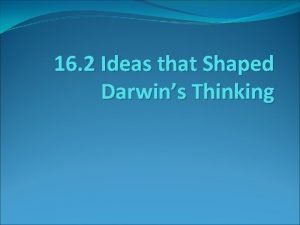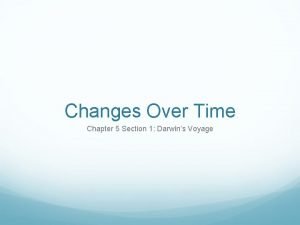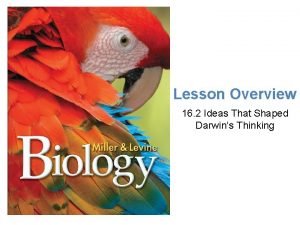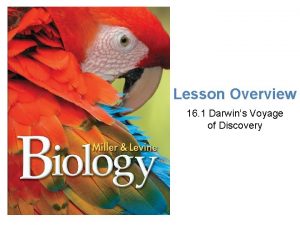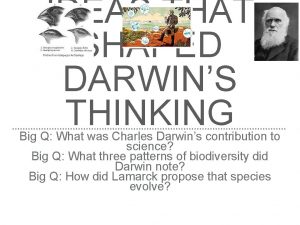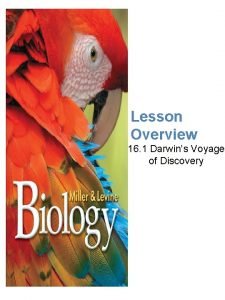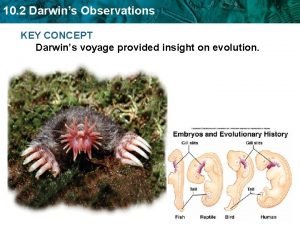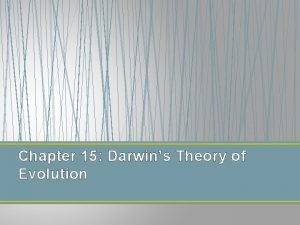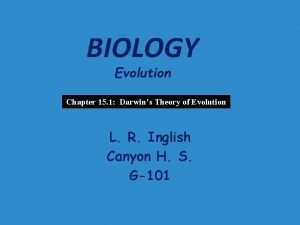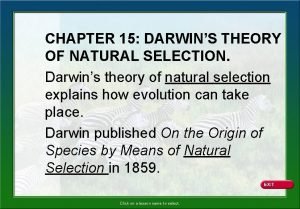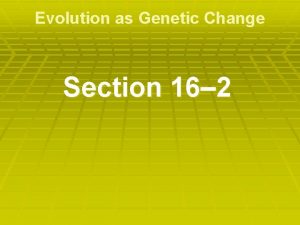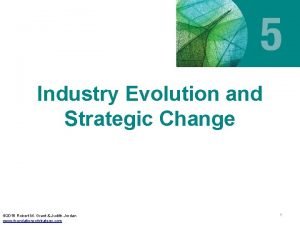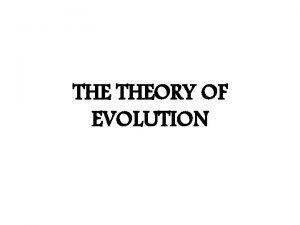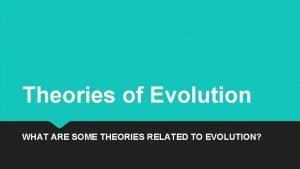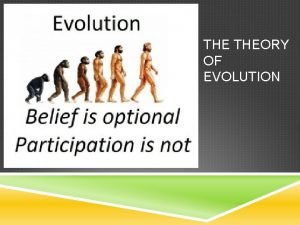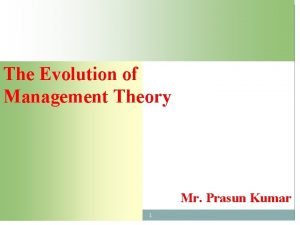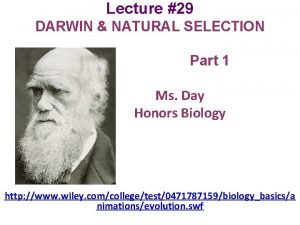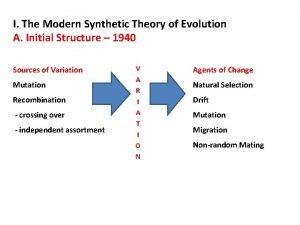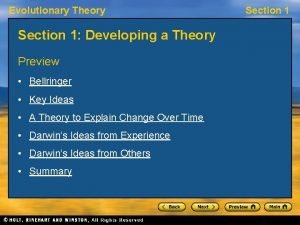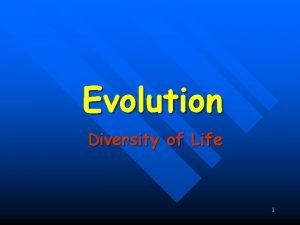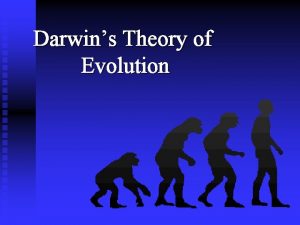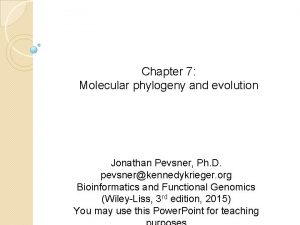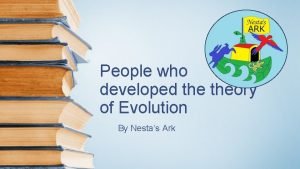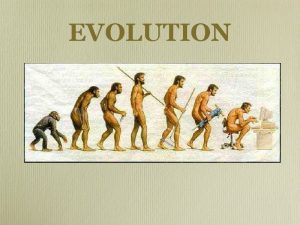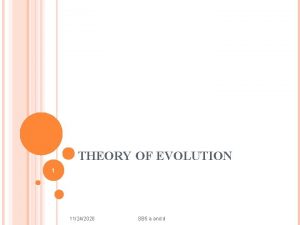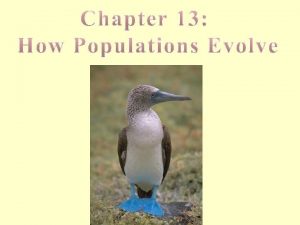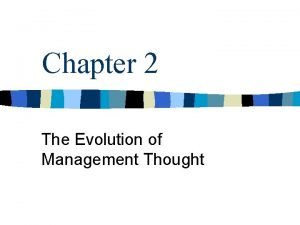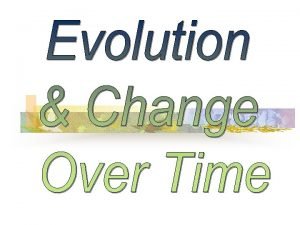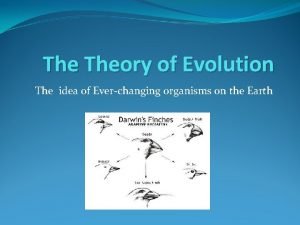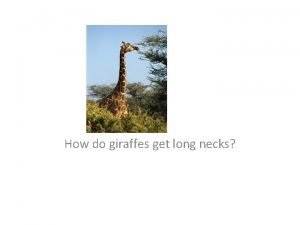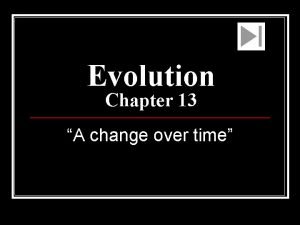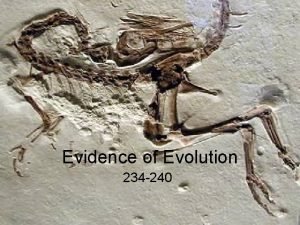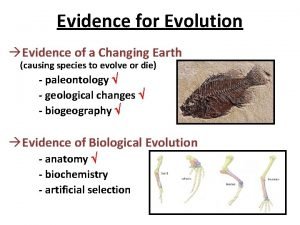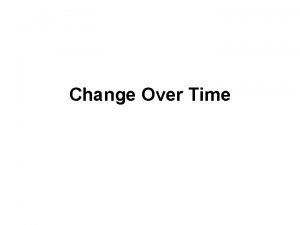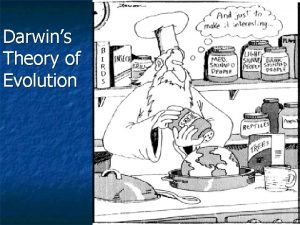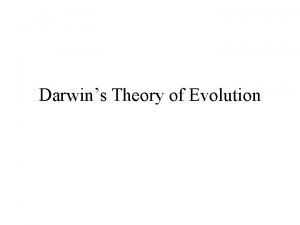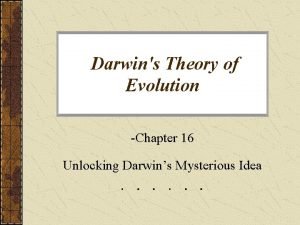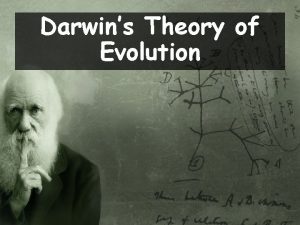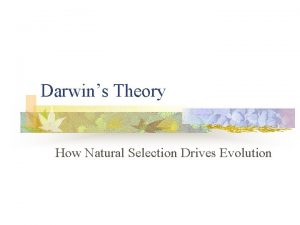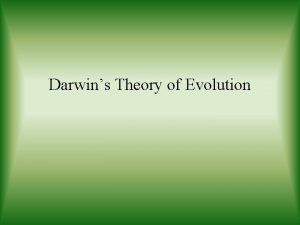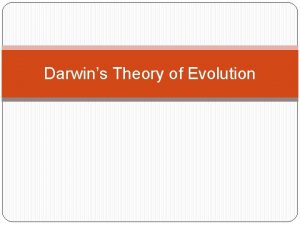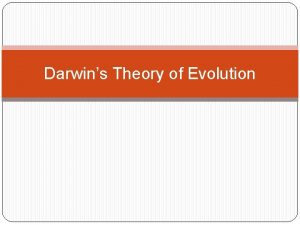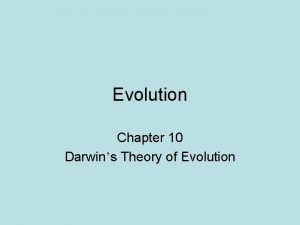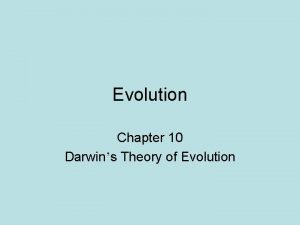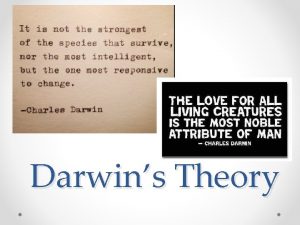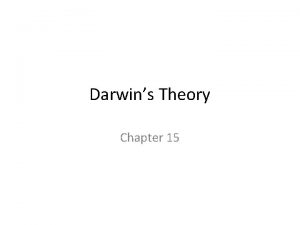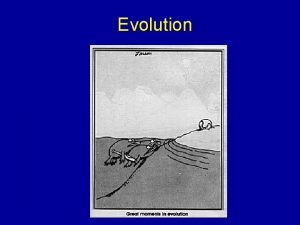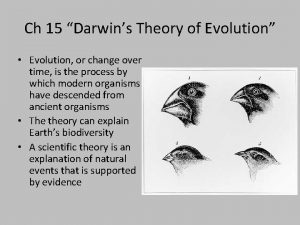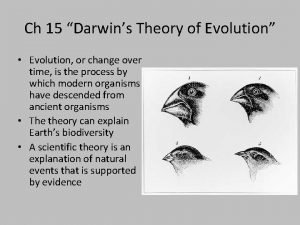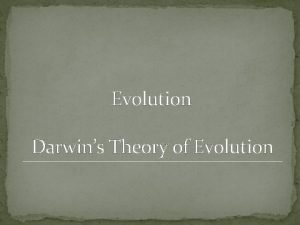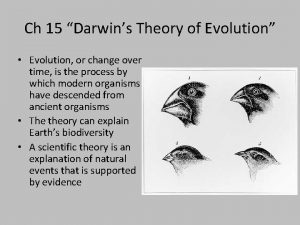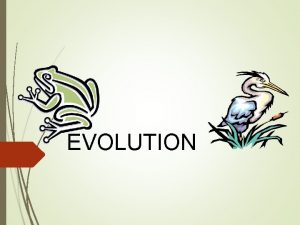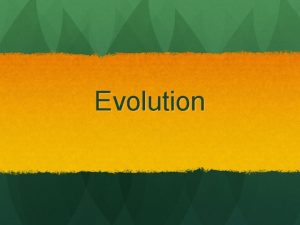Chapter 15 Darwins Theory of Evolution change in










































- Slides: 42

Chapter 15: Darwin’s Theory of Evolution: change in a population over time (Long Periods of Time) Charles Darwin

The Voyage - 1831 • H. M. S. Beagle – The Ship • A voyage around the world – The Mission

What was Darwin’s job on this mission? Make observations & collect evidence Darwin was very fascinated by the Land Tortoises, Marine Iguanas and the Finches of the Galapagos Island

Blue Footed Boobies Marine Iguanas Frigatebird

All These Observations (3 Main Points): 1. Patterns of Diversity-He was puzzled by where different species lived and didn’t live. Ex. Australia and Argentina are both grassland ecosystems, but had very different species. 2. Some living organisms and fossils he collected were very similar.

3. The Galápagos Islands, though close together, had very different climates and had organisms with characteristics that varied noticeably. Pinta Island – Intermediate shell Hood Island. Saddle back shell Isabela Island- Dome shaped shell Reasons for variations?

All great thinkers need inspiration…… • James Hutton (1785) – Proposed that Earth was shaped by geological forces that took place over extremely long periods of time. He estimated the Earth to be millions of years old. He wrote the "Theory of the Earth“. • Thomas Malthus (1798) – The human population was growing faster than the space and food needed to provide for it. Natural disasters and forces of nature would solve the problem.

Other good thinkers… • Jean-Baptiste Lamarck (1809) – One of first to propose a mechanism of how things change over time, and that all species were descended from other species. Common Descent • Lamarck's scientific theories were largely ignored or attacked during his lifetime; Lamarck never won the acceptance and esteem of his colleagues and he died in poverty and obscurity.

His Theory: By selective use or disuse of organs, organisms acquired or lost certain traits during their life time

• Example: A giraffe acquired its long neck because its ancestor stretched higher and higher into the trees to reach leaves, and that the animal’s increasingly lengthened neck was passed on to its offspring.

The Light Bulb Goes Off… • Charles Lyell (1833) – Wrote Principles of Geology, made Darwin ask himself: “If the earth can change over time, then why can’t the things on it? ” “ It must have taken life many, many years to change. ”

A Little Support for Natural Selection • Alfred Wallace (1858) – Writes to Darwin with his own findings supporting the idea of evolution by natural selection.

Darwin’s Theory All these observations and influences led to a revolutionary theory about the way life changes over time. What is a Theory? – well-supported testable explanation of phenomena that have occurred in the natural world 1859 Darwin published his book: On the Origin of Species “Life changes over time by the process of natural selection. ”

The Theory • Organisms have a tendency toward overproduction (seeds, offspring) because not all organisms will survive.

Struggle for Existence • Members of each species compete regularly to obtain food, living space and other necessities of life.

The Theory 2. Variations exist in any population and some are inherited.

The Theory 3. Individuals better suited to their environment live longer and therefore produce more offspring than those less suited.

Survival of the “Fittest” Fitness results from adaptations that give an organism advantages for survival. The most “fit” organisms will survive and reproduce; passing along the advantageous characteristics to their offspring. These changes are usually only be seen after many generations!

Types of Adaptations • Structural adaptations are traits that involve the physical structure of an organism such as the beaks of birds. • Physiological adaptations are traits that involve the functions of an organism such as having enzymes to digest food. • Behavioral adaptations are things organisms do to survive such as birds laying eggs in a nest instead of on the ground.

The Theory 4. The entire population will change as those better suited continue to reproduce, meaning the population becomes better adapted to its environment.

Descent with Modification • As organisms change over time; they become different, resulting in many varied species. This illustrates “common descent. ” All living things have a common ancestor.

Patterns in Evolution Gradualism Punctuated Equilibrium Change is slow and continual. Populations stay the same then change drastically. ex) Mass Extinctions

Day Two: Natural Selection Evidence to Support the Theory

Let’s Recap…The Theory 1. Organisms have a tendency toward overproduction (seeds, offspring) because not all organisms will survive. 2. Variations exist in any population and some are inherited. 3. Individuals better suited to their environment live longer and therefore produce more offspring than those less suited. 4. The entire population will change as, those better suited continue to reproduce, meaning the population becomes better adapted to its environment.

Evidence…… 1 Fossil record 2 Geographic Distribution of Living Species 3 Homologous Body Structures 4 Similarities in Early Development 5 Biochemical Evidence

1. Fossil Record Preserved Fossils Amber Cast/Mold Fossils Trace Fossils Footprint

Determining the Age of a Fossil 1. Relative Dating n n n tell when organisms lived in reference to other organisms older organisms show simpler body structure, while more recent organisms are more complex many fossils show strong similarities to existing organisms

Determining the Age of a Fossil 2. Radioactive Dating Calculate a more accurate age for a fossil based on the amount of radioactive isotopes that remains.

2. Geographic Distribution Beaver Muskrat NORTH AMERICA Muskrat Beaver and Muskrat Coypu Capybara Coypu and Capybara SOUTH AMERICA Coypu Darwin realized that similar animals in different locations could be unrelated species.

2. Geographic Distribution Different variations in populations, due to environmental pressures still share similarities due to a common ancestor

3. Homologous Body Structures • Parts of different organisms that are similar in structure but serve different purposes • Suggest evolutionary descent from a common ancestor • Examples include forelimbs of a horse, bat, whale, & human

Homologous Body Structures Comparative Anatomy Turtle Alligator Primitive Fish Bird Mammals

Homologous structures n n n Bird Horse Human Parts of different organisms that are similar in structure but serve different purposes Suggest evolutionary descent from a common ancestor Examples include forelimbs of a horse, bat, whale, & human

Vestigial organs v serve little or no function v remnants of organs that were once functioning in an ancestral form v examples: human appendix, human ear muscles

4. Similarities in Early Development v examples include similar vertebrate embryos in pigs & humans v similarities suggest a common ancestor

5. Biochemical Evidence • DNA • RNA • Proteins

Evidence of Evolution includes The fossil record Geographic distribution of living species Homologous body structures Similarities in early development which is composed of which indicates which implies Physical remains of organisms Common ancestral species Similar genes

Once again…. . Theory • Organisms have a tendency toward overproduction (seeds, offspring) because not all organisms will survive.

Once again…. . Theory 2. Variations exist in any population and some are inherited.

Once again…. . Theory 3. Individuals better suited to their environment live longer and therefore produce more offspring than those less suited.

Once again…. . Theory 4. The entire population will change as those better suited continue to reproduce, meaning the population becomes better adapted to its environment.

The Theory 1. Organisms have a tendency toward overproduction (seeds, offspring) because not all organisms will survive. 2. Variations exist in any population and some are inherited. 3. Individuals better suited to their environment live longer and therefore produce more offspring than those less suited. 4. The entire population will change as, those better suited continue to reproduce, meaning the population becomes better adapted to its environment.
 Www.bf.tku.edu.tw/files/news chapter 17
Www.bf.tku.edu.tw/files/news chapter 17 Chapter 15 section 1 darwins theory of natural selection
Chapter 15 section 1 darwins theory of natural selection What was darwins theory
What was darwins theory Section 15-2 ideas that shaped darwin's thinking
Section 15-2 ideas that shaped darwin's thinking 15-2 ideas that shaped darwin's thinking
15-2 ideas that shaped darwin's thinking Section 2 darwins observations study guide a
Section 2 darwins observations study guide a Ideas that shaped darwin's thinking
Ideas that shaped darwin's thinking Species that vary locally
Species that vary locally Ideas that shaped darwins thinking
Ideas that shaped darwins thinking Lesson 1 darwins voyage of discovery
Lesson 1 darwins voyage of discovery Darwins observations
Darwins observations Chapter 15 darwin's theory of evolution
Chapter 15 darwin's theory of evolution Chapter 15 darwin's theory of evolution section 15-1
Chapter 15 darwin's theory of evolution section 15-1 Chapter 15 darwin's theory of evolution section 15-1
Chapter 15 darwin's theory of evolution section 15-1 Natural selection
Natural selection 16-2 evolution as genetic change
16-2 evolution as genetic change Industry evolution and strategic change
Industry evolution and strategic change Model of evolution showing slow change
Model of evolution showing slow change Lamarck's theory of evolution
Lamarck's theory of evolution What does the theory of evolution state
What does the theory of evolution state Evolution of management theory
Evolution of management theory 3 types of natural selection
3 types of natural selection Modern synthetic theory of evolution notes
Modern synthetic theory of evolution notes Modern evolution theory
Modern evolution theory Lamarck’s theory of evolution.
Lamarck’s theory of evolution. Vestigial
Vestigial Neutral theory of molecular evolution notes
Neutral theory of molecular evolution notes Shaping evolutionary theory
Shaping evolutionary theory Charles darwin theory of evolution
Charles darwin theory of evolution Who formulated theory of evolution? *
Who formulated theory of evolution? * Lamarck theory of evolution notes
Lamarck theory of evolution notes Theory of evolution
Theory of evolution Theory of evolution
Theory of evolution Chapter 2 the evolution of management thought pdf
Chapter 2 the evolution of management thought pdf Homologous structures example
Homologous structures example Theory of evolution summary
Theory of evolution summary Modern theory of evolution
Modern theory of evolution Darwin's theory of evolution
Darwin's theory of evolution Convergent evolution
Convergent evolution The theory that evolution occurs slowly but steadily
The theory that evolution occurs slowly but steadily Biochemical evidence examples
Biochemical evidence examples The theory that evolution occurs slowly but steadily
The theory that evolution occurs slowly but steadily Is cutting paper a physical change
Is cutting paper a physical change

